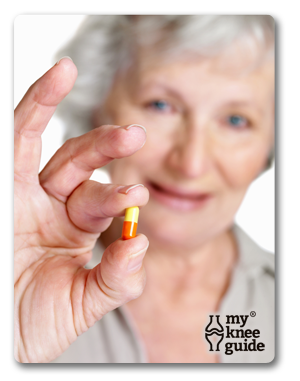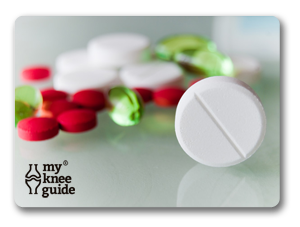

Many patients will be treated with anti-inflammatory medicine (also known as NSAIDs) for knee arthritisknee arthritis. Examples of these medicines include Motrin®, Naproxen®, and Celebrex®. A more extensive list can be found in the NSAID moduleNSAID module. For some patients, these medicines can be very effective, especially if the arthritis is mild to moderate. However, as the arthritis progresses, the pain can be more difficult to manage with medicine. There are several different classes of anti-inflammatories. Patients may find a better effect from one class versus another. This is the reason that physicians may try several different types of NSAIDs when treating knee arthritis.

The use of topical (applied to the skin with a cream or patch) NSAIDs may also provide symptomatic relief from knee arthritis as well. An example of this is Voltaren® gel.
Oral NSAIDs should be taken with food since they can irritate the stomach, cause ulcers or bleeding. Also, long term use of these medicines can injure the kidneys. If a patient uses these medicines on a regularl basis, it is recommended to have some routine labsroutine labs checked.
On July 9, 2015, the FDA has also issued a warning that non-apirin over-the-counter (OTC) and prescription NSAIDs can increase the risk of heart attacks and stroke. This risk can occur within the first week of use of the medicine and is found even in patients with no prior history or risk factors for heart disease or stroke.11
Acetaminophen (commonly known as Tylenol®) is not categorized as an anti-inflammatory medicine. It may be effective in treating some osteoarthritis pain. In some circumstances it may be recommended to alternate treatment between acetaminophen and NSAIDs. However, it is not advised to combine the use of two or more NSAIDs. Combining multiple NSAIDs increases the risk of bleeding and stomach problems. Patients must also be cautious to prevent themselves from taking too much acetaminophentoo much acetaminophen. To find more resources about over-the-counter (OTC) medicines, we recommend visiting knowyourotcs.orgknowyourotcs.org.


In a report on evidence-based orthopaedics published in April of 2010, the American Academy of Orthpaedic Surgeons stated that they do not recommend the use of oral glucosamine and/or chondroitin sulfate for the treatment of symptomatic osteoarthritis of the knee.
Rarely, narcotic medicine is used to help treat the symptoms of knee arthritis. When used as a treatment for chronic arthritis, narcotics become addictive. Additionally, the body builds up a tolerance to this type of medicine and requires higher doses to obtain an effect. Long term use of narcotics to treat the symptoms of arthritis should be avoided.
Once a patient has completed their course of medicines, there may be some left over pills from their treatment. Here is a guide for the proper disposal of these medicines. NSAIDs and acetaminophen may be disposed of in the household trash in the following manner:
- Mix medicines (do not crush tablets or capsules) with an unpalatable substance such as dirt, kitty litter, or used coffee grounds
- Place the mixture in a container such as a sealed plastic bag
- Throw the container in your household trash
- Scratch out all personal information on the prescription label of your empty pill bottle or empty medicine packaging to make it unreadable, then dispose of the container.
However, if the pain medicine contains narcotics, then there are other preferred methods for disposal. One option is to contact a DEA-authorized collectorDEA-authorized collector to return the medicine. The FDA also recommends another option which is to flush the medicine down the toilette to help reduce the chance that others may accidentally take or intentionally misuse the unneeded medicine. The current list of medicines that are recommended for flushinglist of medicines that are recommended for flushing can be found on the FDA website.














